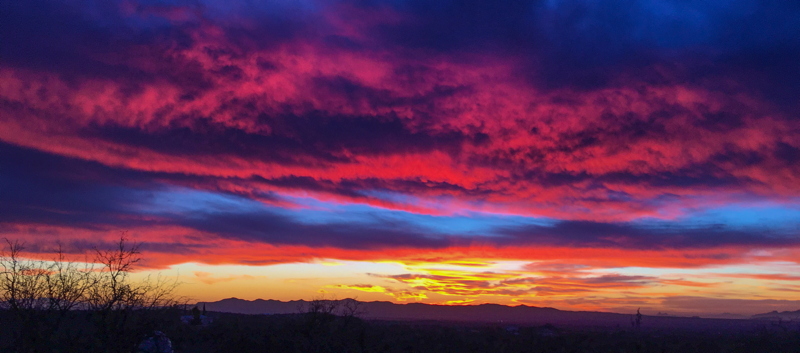Mighty ETX-105PE Observing & iPhone 6s Plus Imaging
Posted: 16 February 2016
After repairing a large section of the observatory patio carpet Saturday morning, 13 February 2016, I checked the repaired area a few times on Saturday and Sunday; it seemed to be OK. Of course, the real test will come with the next rain/snow.
The sky was clear during the day on Sunday, 14 February, and I decided I would use my Meade ETX-105PE from inside the POD that evening. Unfortunately, unforecasted clouds came in late in the afternoon and by sunset the sky was mostly overcast. There was a pretty sunset however:

Monday, 15 February, was mostly clear so I took the Meade ETX-105PE telescope to the observatory.
|
Open: Monday, 15 February 2016, 1804 MST Temperature: 72°F |
Session: 919 Conditions: Mostly clear |
1810 MST: sunset. Set up the ETX-105PE inside the SkyShed POD:

1824 MST: powered on the ETX-105PE and let the LNT (Level North Technology) module do its auto tilt/north/align. 1830 MST: Auto Align was completed. Did a GOTO the Moon and viewed it using the 26mm eyepiece (57X). Lovely view. Switched to a 9.7mm eyepiece (152X) and did some lunar viewing. As expected for an ETX telescope, the views of the Moon were awesome. Very nice details along the lunar terminator.
Mounted the iPhone 6s Plus on the ETX-105PE using the Orion SteadyPix Universal Smartphone Telescope Photo Mount and took this afocal 57X image (full-frame) using the iOS Camera app:

Then added the Meade 3X TeleXtender (yielding 170X) for this series of afocal photos (Camera app) along the terminator:



Removed the iPhone and SteadyPix and switched to a 5.5mm eyepiece (267X) and viewed some of the sights along the terminator. Montes Apenninus was especially impressive. This is Montes Apenninus, handheld iPhone afocal 267X image (cropped from the full-frame photo), Camera app:

1858 MST: last look at the Moon, 57X. Slewed to M42 (Orion Nebula) and viewed it, 57X. Some nebulosity was visible, but the sky was too bright for good viewing. The Trapezium stars were good though.
1913 MST: Uranus, 57X. Small disk visible.
Next, viewed M31 (Andromeda Galaxy), 57X. Its companion galaxy M32 was easily seen, but its companion galaxy M110 was only faintly visible due to the moonlit sky.
1923 MST: viewed the Double Cluster, 57X. Pretty view in the ETX-105PE. Mounted the iPhone with the SteadyPix and used NightCap Pro (Long Exposure, Light Boost, ISO 4000, 1/3sec, 5 second exposure) for this cropped image of the Double Cluster:

1938 MST: took a final look at M42 with the Mighty ETX-105PE, 57X.
|
Close: Monday, 15 February 2016, 1954 MST Temperature: 58°F |
Session Length: 1h 34m Conditions: Mostly clear |
The LX600 tripod is on track for delivery on Tuesday, 16 February.
Comments are welcome using Email. If you are on Twitter you can use the button below to tweet this report to your followers. Thanks.
Cassiopeia Observatory Home Page
Copyright ©2016 Michael L. Weasner / mweasner@me.com
URL = http://www.weasner.com/co/Reports/2016/02/16/index.html
